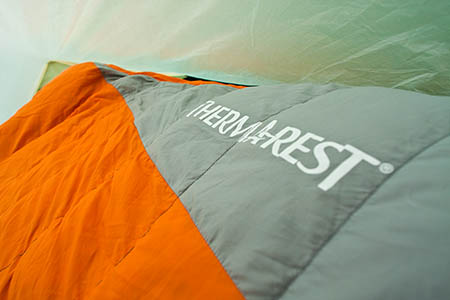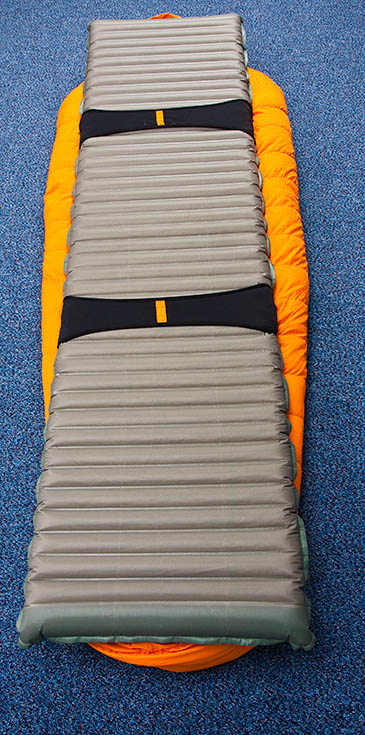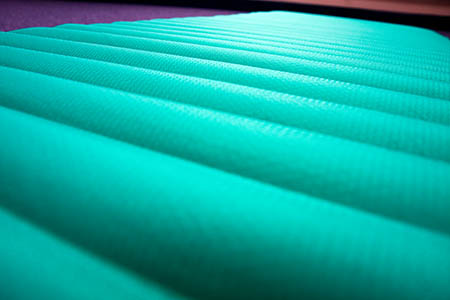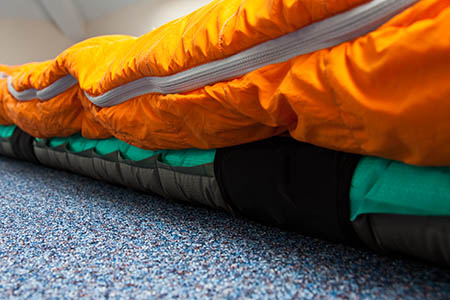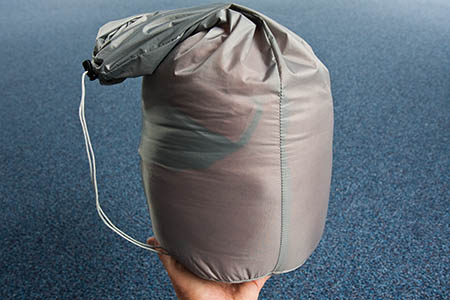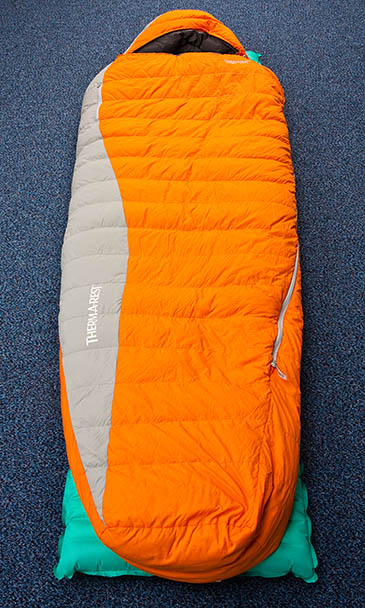Therm-a-Rest NeoAir All Season sleeping mat
Country of manufacture: Ireland
Weight: 540g
Price: £125
Colour: green
Material: top: 75 denier polyester; bottom 70 denier nylon; inner: nylon
Size (R) 51 x 183 cm (20 x 72 inches)
Therm-a-Rest Antares 20 down sleeping bag
Country of manufacture: China
Weight: 890g
Price: £250
Colour: orange/grey
Material: outer, 30 denier nylon with durable water repellent treatment; lining, 30 denier nylon; filling, 750+ goose down
Size (R) 198 cm length x 158 cm circumference at shoulder
Temperature rating: EN comfort 1C; EN limit –5C; EN extreme –22C
Therm-a-Rest became a by-word for the self-inflating sleeping mat, though they always benefited from a little help from the lungs.
Things have moved on a lot from those early days and, courtesy of the Seattle-based company, we tested the latest inflatable sleeping mat, the NeoAir All Season, along with one of Therm-a-Rest’s new sleeping bags.
We used the Antares 20 sleeping bag together with the NeoAir All Season mat for one simple reason: they’re designed to work with each other.
Therm-a-Rest has ditched the bottom layer of insulation fill in the sleeping bag; it has only a fabric base. This allows more down to be distributed on the top of the bag and at the sides while keeping weight down.
The top has 70 per cent of the down and the sides 30 per cent. Obviously, this means you need something to stop your body heat escaping downwards into the ground when camping, and that’s where the NeoAir mattress comes in.
The two items use Therm-a-Rest’s SynergyLink connectors to strap the bag to the mat. These are two stretchy fabric bands on the bottom of the bag that wrap around the mat to keep the two together.
The advantage of this in practice is that you don’t suffer from that all-too-common mid-sleep annoyance of finding you and your sleeping bag have parted company with the mat and you are now sleeping on a cold ground sheet.
The Neo-Air All Season air mattress can, of course, be used with any sleeping bag. It has a tough feeling polyester and nylon outer with a series of internal baffles arranged, Therm-a-Rest says, so that body heat is reflected back upwards and the cold rising from the ground is kept down.
The mattress takes about 20 good sized breaths to inflate. Stop half-way and close the valve, then roll the mat so the air is forced into the bottom part. Then open the valve again and complete the inflation.
If you find it’s a bit too firm, just open the valve briefly to let some air out. As soon as you lie on the NeoAir All Season, you can feel its insulating properties.
If it’s cold and you’re worried about condensation building inside the mat from exhaled breath, the mat’s stuff sack doubles as an inflator by attaching the plastic end to the mat’s valve, then squeezing air from the sack into the bag. However, this is a bit laborious and slow and inflating the mat by mouth is much easier.
The NeoAir has more than 100 internal cells with reflective barriers, giving it an R-value of 4.9. To give you some idea of what that means, a basic closed-cell foam sleep mat would typically have an R value of a little over 2.
Anyone accustomed to the Spartan comfort of a self-inflating mat or even a simple foam mat will be delighted at the comfort the NeoAir All Season mat gives.
Its 6.3cm (2½-inch) air-filled cushioning makes for a very comfortable night’s sleep, both in terms of warmth and support. The surface isn’t slippery either and, as the bag is strapped to the mat, it stays in place as you move around during sleep.
Out on the trail, we used the bag and mattress in a variety of temperatures between a mild summer night and a cool, windy early autumn night.
The Antares 20 is definitely a three-season bag and a warmish night during this unusually good summer meant a bit of overheating, but this was easily cured by partly unzipping the bag and uncovering until the correct amount of warmth was gained.
The bag has a good, smooth-running two-way zip so can be opened from the bottom to provide some ventilation too.
As the temperature dropped, the sleeping bag came into its own. It is rated for comfort at 1C and its lower limit is –7C. We never felt cold in any of the conditions when we used the Antares 20 with the NeoAir All Season mat.
The Antares has Therm-a-Rest’s Efficient Comfort Fit, which has extra space at the shoulders and hips but is narrow at places such as the feet and head to increase warmth. What this means is that the bag pretty much stays put when you roll on to your side to sleep, rather than rotating with you, a good feature that adds to the sleeping comfort.
It has neck padding to help stop heat escape and the hood has a drawstring. The sleeping bag also has a small, zipped stash pocket, large enough to take a smartphone.
The Antares comes with a large storage bag to keep it in when at home, so it’s not compressed, and a stuff sack for when you’re on the trail. Having down fill rather than synthetic insulation means it compresses down very small, a boon for backpacking.
One drawback of the stuff sack, however, is that it doesn’t have a spider to keep it compressed, so the bag tends to slowly expand after you’ve got it into the sack. Stuffing the whole thing into a confined part of your rucksack will keep it nicely compressed though, we found.
Equally, the NeoAir mat takes up little space. In its stuff sack, it measures about 20 x 8 cm (8 x 5 inches).
The bag and mat combined weigh less than 1.5kg, an acceptable weight in our view for the comfort they provide.
The NeoAir All Season is a fairly narrow mat at 51cm, though we found that presented no problems.
There is a larger version available at 63cm which also has an extra length that should accommodate those over six feet tall.
The Therm-a-Rest sleeping bag and mat provided untroubled sleeping on our travels and the quality and design are as good as we have come to expect from the brand.
Of course, you don’t have to use the two together. The NeoAir All Season mat in particular is a versatile piece of kit providing comfort and warmth with a small pack size and reasonable weight.
The Antares 20 sleeping bag could also be used with other insulating sleep mats too, as the stretch straps under it should accommodate most mats. Just remember there is no insulation under the body, so make sure you choose a mat that will keep the cold out.
Therm-a-Rest’s venture into the sleeping bag market can, we reckon, be gauged a success and the NeoAir All Season mat continues the innovation and quality for which the brand is known.
Down bags need to be kept dry as the insulation won’t work well if the filling clumps when it gets wet, but the Antares has a DWR treatment and we didn’t experience any problems during our tests.
And the mat comes with a puncture repair kit in case of mishaps.
The Antares 20 compares well weight-wise with similar down bags offering similar comfort temperatures, because of its clever construction, and is priced competitively too for a sleeping bag of its specs.
The NeoAir All Season mat is at the top end of the sleeping mat price scale, but its comfort and warmth make it a great addition to a backpacker’s pack.
More details are on the Therm-a-Rest website.
Therm-a-Rest NeoAir All Season sleeping mat
Warmth 33/35
Comfort 33/35
Design 8/10
Quality 8/10
Value for money 5/10
Total score: 88/100
Therm-a-Rest Antares 20 sleeping bag
Warmth 31/35
Comfort 33/35
Design 8/10
Quality 8/10
Value for money 7/10
Total score: 87/100
